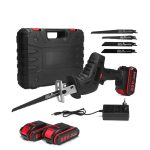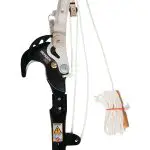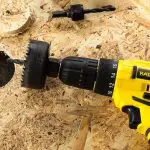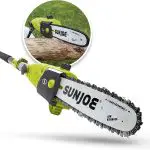To use an electric hand saw, first, make sure the saw is properly plugged in and the blade is securely attached. Then, hold the saw with both hands, grip the handles firmly, and position the blade where you want to make the cut.
Press the trigger to turn the saw on, and slowly guide the blade through the material, applying gentle pressure. Remember to wear safety goggles and gloves for protection. Using an electric hand saw requires proper technique and safety precautions to ensure accurate cuts and avoid accidents.
We will discuss step-by-step instructions on how to effectively and safely use an electric hand saw. Whether you are a beginner or an experienced DIY enthusiast, this guide will provide you with valuable tips and insights on using this powerful tool. By following these instructions, you can confidently tackle various projects that require cutting through wood, metal, or other materials. So let’s dive in and learn how to use an electric hand saw like a pro.
Understanding Electric Hand Saws
Learn how to effectively use an electric hand saw with these easy-to-follow tips and techniques. Get a step-by-step guide on how to handle and operate an electric hand saw to make your DIY projects a success.
Overview Of Electric Hand Saws:
An electric hand saw is a versatile power tool that can make cutting through various materials easier and more efficient. These portable saws are compact and lightweight, making them ideal for DIY projects or small-scale professional tasks. Electric hand saws are designed to be easy to handle and offer precision cutting capabilities.
They are powered by electricity, eliminating the need for manual effort and providing consistent power for efficient cutting.
Different Types Of Electric Hand Saws:
There are several types of electric hand saws available, each designed for specific purposes and materials. Understanding the differences between these types will help you choose the right one for your project:
- Circular Saw: This type of saw has a round blade that spins rapidly to make straight or bevel cuts in various materials. It is commonly used for cutting wood, but some models can also cut through metal or plastic.
- Jigsaw: A jigsaw features a small, reciprocating blade that moves up and down rapidly. It is perfect for cutting curves, irregular shapes, and intricate designs in wood, plastic, or metal.
- Reciprocating Saw: Also known as a saber saw or recip saw, this type of saw has a straight blade that moves back and forth in a reciprocating motion. It is ideal for aggressive cutting tasks, such as demolition work or cutting through thick branches.
- Band Saw: A band saw uses a continuous band of teethed metal stretched between two wheels to cut through a variety of materials. It is commonly used in woodworking, metalworking, and other specialized applications.
Choosing The Right Electric Hand Saw For Your Project:
Selecting the right electric hand saw for your project will ensure optimal performance and efficiency. Consider the following factors when choosing a saw:
- Power: Look for a saw with sufficient power to handle the materials you will be cutting. Higher power ratings typically indicate more cutting versatility.
- Blade Size: The size of the blade determines the depth of cut the saw can achieve. Consider the thickness of the materials you will be working with and ensure the saw can accommodate them.
- Cutting Capacity: Different saws have different cutting capacities. Consider the maximum thickness the saw can handle to ensure it meets your project requirements.
- Features and Accessories: Look for additional features and accessories that can enhance your cutting experience, such as laser guides, LED lights, or dust extraction systems.
- Ergonomics: Consider the weight, grip, and overall comfort of the saw. Make sure it feels comfortable in your hand and is easy to maneuver for extended periods.
Remember to always prioritize safety when using an electric hand saw. Follow all manufacturer guidelines, wear appropriate protective gear, and use caution to prevent accidents or injuries.

Credit: www.bobvila.com
Safety Precautions And Equipment
Learn how to use an electric hand saw safely and effectively with the right precautions and equipment. Follow these guidelines to ensure your safety and achieve accurate cuts every time.
Importance Of Safety When Using Electric Hand Saws:
Using an electric hand saw can be a great way to tackle various projects around the house or on a job site. However, it is essential to prioritize safety when using this powerful tool. Here are some key points to consider:
- Operating an electric hand saw without taking proper safety precautions can lead to serious injuries. By following safety guidelines, you can reduce the risk of accidents and ensure a safe working environment.
- Unintended contact with the blade can result in severe cuts or amputations. It is crucial to handle the saw with caution and always keep your hands away from the cutting area.
- The high-speed rotating blade can produce flying debris, including chips and sawdust. Wearing appropriate safety equipment will protect your eyes and face from potential hazards.
- The noise generated by an electric hand saw can reach harmful levels. Using hearing protection, such as earplugs or earmuffs, is crucial to prevent long-term hearing damage.
- Electric hand saws produce vibrations during operation, which can lead to hand-arm vibration syndrome (HAVS) if used for extended periods without proper precautions. Wearing anti-vibration gloves can help minimize the risk.
Remember, safety should never be compromised when working with power tools. By understanding and implementing the necessary safety measures, you can ensure a safe and accident-free experience when using an electric hand saw.
Essential Safety Equipment For Using An Electric Hand Saw:
To ensure your safety when using an electric hand saw, it is essential to have the right equipment on hand. Here are some key safety items you should use:
- Safety Glasses: Protect your eyes from flying debris, such as wood chips or metal shavings, by wearing safety glasses with side shields.
- Face Shield: For added protection, consider wearing a face shield to shield your entire face from potential hazards. This is especially important when cutting materials that may splinter or break apart.
- Hearing Protection: Electric hand saws can produce a high level of noise that can damage your hearing over time. Use earplugs or earmuffs to reduce exposure to loud noise.
- Anti-vibration Gloves: Vibrations produced by the saw can cause hand-arm vibration syndrome. Protect your hands by wearing anti-vibration gloves that help absorb or reduce the impact of vibrations.
- Respirator: When cutting materials that generate substantial dust or fumes, wearing a respirator can prevent inhalation of harmful particles and ensure clean air intake.
- Sturdy Work Gloves: Use durable, non-slip gloves to provide a firm grip on the saw and materials, reducing the risk of accidental slips or loss of control.
- Protective Clothing: Wear long-sleeved shirts, long pants, and closed-toe shoes to protect your body from potential cuts, scratches, or debris.
- Workbench or Clamps: Secure your materials to a stable workbench or use clamps to prevent them from shifting during cutting, ensuring more precise and controlled cuts.
By using the correct safety equipment, you can significantly reduce the risk of injury and create a safer working environment when operating an electric hand saw.
Proper Handling And Maintenance Of An Electric Hand Saw:
To make the most of your electric hand saw and ensure its longevity, proper handling, and maintenance are essential. Follow these guidelines to optimize your saw’s performance and safety:
- Read the User Manual: Familiarize yourself with the manufacturer’s instructions to understand the specific safety guidelines, operational procedures, and maintenance requirements for your electric hand saw.
- Inspect the Saw: Before each use, visually inspect the saw for loose or damaged parts. Check if the blade is secure and sharp, and ensure the power cord is in good condition.
- Work in a Well-lit Area: Adequate lighting helps you see the cutting area clearly, minimizing the chances of mistakes or accidents.
- Use Both Hands: Maintain a firm grip on the saw with both hands to maintain control and stability during operation.
- Keep a Stable Stance: Stand with your feet shoulder-width apart and maintain a balanced posture while operating the saw. This ensures better control and minimizes the risk of losing balance.
- Avoid Overreaching: Position yourself in such a way that you can comfortably reach the cutting area without stretching or overextending your body.
- Secure the Workpiece: Always secure the workpiece firmly before cutting. This can be done using clamps, a workbench, or other appropriate fixtures to prevent movement during the cutting process.
- Do not Force the Saw: Let the blade’s teeth do the cutting work. Excessive force may lead to kickback or damage the saw.
- Disconnect Power Before Blade Changes or Adjustments: Prior to changing the blade or making any adjustments to the saw, disconnect it from the power source to avoid accidental starts.
- Clean and Lubricate: Regularly clean the saw’s surface, remove debris, and lubricate movable parts as per the manufacturer’s instructions to ensure smooth and efficient operation.
By following these handling and maintenance practices, you can enhance the safety and longevity of your electric hand saw, allowing for more precise and effective cutting.
Step-By-Step Guide To Using An Electric Hand Saw
Discover the step-by-step guide to effectively using an electric hand saw. Learn how to adjust the blade, handle safety measures, and make precise cuts for your woodworking projects.
Familiarizing Yourself With The Parts Of An Electric Hand Saw:
- Blade: The sharp cutting component of the saw that is attached to the motor.
- Motor: Powers the blade and provides the cutting action.
- Handle: The part of the saw that you grip to control its movement.
- Trigger: The button or lever that activates the motor.
- Depth adjustment: This allows you to set the cutting depth of the blade.
- Blade guard: A protective cover that shields the blade when not in use.
Setting Up Your Work Area For Using The Electric Hand Saw:
- Clear the area: Remove any obstacles or debris that may interfere with your work.
- Secure your materials: Use clamps or other methods to secure your workpiece.
- Provide adequate lighting: Ensure you have enough light to see your cutting line clearly.
- Wear safety gear: Put on safety goggles, ear protection, and gloves before using the saw.
- Create a safe perimeter: Keep bystanders at a safe distance to prevent accidents.
Adjusting The Blade And Depth Settings:
- Blade installation: Follow the manufacturer’s instructions to install the blade securely.
- Check the blade alignment: Ensure the blade is straight and aligned with the saw’s base.
- Adjust the cutting depth: Set the desired cutting depth according to your project requirements.
- Secure the depth adjustment: Double-check that the depth lock is properly engaged.
Proper Technique For Holding And Cutting With An Electric Hand Saw:
- Grip the saw firmly: Hold the handle with a steady, yet comfortable, grip.
- Position the saw correctly: Align the blade with the cutting line and keep it parallel to your workpiece.
- Apply gentle pressure: Allow the saw’s weight and the blade’s sharpness to do the work.
- Use controlled movements: Maintain a steady and smooth cutting motion while guiding the saw along the cutting line.
- Avoid forcing the saw: Let the saw’s motor power through the cut without excessive pressure.
Tips For Making Precise And Accurate Cuts:
- Mark your cutting line: Use a pencil or a marker to clearly indicate the desired cut.
- Follow the line: Keep your eyes on the marked line and guide the saw accordingly.
- Take your time: Slow, steady cuts are more accurate than rushed ones.
- Make test cuts: Practice on scrap materials to get a feel for the saw’s performance.
- Use a guide: If necessary, use a straight edge or guide to ensure straight cuts.
Remember to always prioritize safety when using an electric hand saw. Familiarize yourself with the saw’s manual, wear appropriate safety gear, and follow recommended guidelines for safe operation.
Advanced Techniques And Tips
Learn advanced techniques and tips on how to effectively use an electric hand saw without any hassle. Discover the best practices for adjusting the depth, changing blades, and ensuring safety while achieving precise cuts. Mastering these skills will make your woodworking projects a breeze.
Cutting Different Materials With An Electric Hand Saw (Wood, Metal, Etc.)
An electric hand saw is a versatile tool that can be used to cut various materials, including wood, metal, and more. Here are some essential tips for cutting different materials with an electric hand saw:
- Wood Cutting Tips:
- Use a fine-toothed blade for clean and precise cuts in wood.
- Adjust the cutting depth according to the thickness of the wood.
- Start the cut at a slow speed and gradually increase as you progress.
- Hold the saw firmly and use steady, controlled movements.
- For thicker pieces of wood, make multiple passes to avoid binding the blade.
- Metal Cutting Tips:
- Use a blade specifically designed for cutting metal.
- Apply cutting oil or lubricant to reduce friction and prevent overheating.
- Take proper safety precautions, such as wearing protective eyewear and gloves.
- Slow down the cutting speed to maintain control and avoid blade kickback.
- Ensure that the metal is securely clamped or held in place before making the cut.
- Other Materials:
- For plastic, choose a blade with finer teeth to prevent chipping or melting.
- When cutting laminate or veneer, use a blade with reverse teeth to prevent splintering.
- When cutting tiles or ceramics, use a diamond-tipped blade for clean and precise cuts.
Remember to always refer to the manufacturer’s instructions for the specific materials you plan to cut and use the appropriate safety measures.
Creating Angled Cuts And Bevels
An electric hand saw allows you to create angled cuts and bevels in your projects. Follow these tips for achieving accurate angled cuts and bevels:
- Adjust the base plate: Most electric hand saws come with a base plate that can be adjusted to different angles. Loosen the base plate locking lever and adjust it to the desired angle. Tighten the lever to secure the base plate in place.
- Use a guide: If you need to make a precise angled cut or bevel, consider using a guide. A guide can help you maintain a straight and steady cut, especially when working with longer pieces of material.
- Mark your cut: Before making an angled cut or bevel, mark the desired angle on your material using a square or protractor. This will serve as a guide to ensure accuracy.
- Practice on scrap material: If you’re new to making angled cuts and bevels, practice on scrap material first. This will allow you to familiarize yourself with the saw’s movement and adjust your technique if needed.
Remember to always work slowly and carefully when making angled cuts and bevels. Measure twice, cut once!
Making Curved Cuts With An Electric Hand Saw
Creating curved cuts with an electric hand saw requires a slightly different approach compared to straight cuts. Here’s how you can make curved cuts with precision:
- Choose the right blade: Use a scroll-cutting or jigsaw blade specifically designed for curved cuts. These blades have smaller teeth and are flexible, allowing for greater maneuverability.
- Mark your cut: Before starting your curved cut, accurately mark the cutting line on the material. You can use a pencil or a marker to mark the desired curve.
- Start with pilot holes: For tighter curves, start by drilling a pilot hole at the edge of the marked line. This will allow you to insert the saw blade and make the initial cut.
- Follow the marked line: Keep the saw blade aligned with the marked cutting line and guide the saw along the curve. Move at a steady pace and let the saw do the cutting.
- Practice control and technique: Making curved cuts requires finesse and control. Practice on scrap material to improve your technique and get comfortable with the saw’s movement.
Remember to always prioritize safety when making curved cuts. Clamp down the material securely, wear appropriate safety gear, and take your time to ensure accurate and smooth cuts.
Troubleshooting Common Issues With An Electric Hand Saw
Sometimes, you may encounter common issues when using an electric hand saw. Here are some troubleshooting tips to help you overcome these problems:
- Blade binding: If the blade gets stuck or binds in the material, stop immediately and turn off the saw. Check if the blade is dull or damaged and replace it if necessary. Make sure the cutting depth is appropriate for the material and avoid forcing the saw through the cut.
- Blade overheating: If the blade becomes hot during use, it may be due to excessive friction. Apply cutting oil or lubricant to reduce friction and let the blade cool down before continuing.
- Uneven cuts: If your cuts are uneven or wavy, ensure that you’re maintaining a straight cutting line and using smooth, steady movements. Check the blade alignment and replace it if needed.
- Excessive vibration: Excessive vibration can affect the accuracy of your cuts and make the saw difficult to control. Check for loose components, such as the blade or base plate, and tighten them as necessary. If the vibration persists, consider getting your saw inspected by a professional.
- Power issues: If the saw is not turning on or experiencing intermittent power, check the power cord for damage or loose connections. Ensure that the power source is working correctly and try plugging the saw into a different outlet or using a different extension cord.
Remember to wear appropriate safety gear, follow the manufacturer’s instructions, and take regular breaks to prevent fatigue when using an electric hand saw.
Frequently Asked Questions On How To Use An Electric Hand Saw?
1. How Do You Use A Hand Saw For Beginners?
To use a hand saw for beginners: 1. Hold the saw firmly with one hand and the material with the other. 2. Align the blade with the desired cut and start sawing with a steady back-and-forth motion. 3. Apply gentle pressure to guide the saw through the material.
4. Take breaks and measure regularly to ensure accuracy. 5. Practice proper safety precautions, such as wearing protective gear and securing the material. 6. Clean and maintain the saw regularly for optimal performance.
2. How Do You Use A Hand Power Saw?
To use a hand power saw, follow these steps: 1. Wear safety goggles and gloves. 2. Secure the material you will be cutting. 3. Hold the saw firmly with both hands. 4. Align the saw blade with the cutting line.
5. Apply steady pressure and move the saw back and forth in a controlled motion. 6. Use a slower pace to prevent the saw blade from overheating. 7. Continue cutting until you reach the desired depth. 8. Release the pressure and remove the saw from the material.
3. How Do You Cut Wood With An Electric Hand Saw?
To cut wood with an electric hand saw, follow these steps: 1. Secure the wood on a stable surface. 2. Align the saw blade with the cutting line on the wood. 3. Hold the saw firmly with both hands and turn it on.
4. Apply gentle pressure while moving the saw along the cutting line. 5. Take breaks to prevent the blade from overheating. 6. Use a continuous motion until the cut is complete. 7. Turn off the saw after cutting and wait for the blade to stop spinning before setting it down.
Conclusion
To sum up, using an electric hand saw can greatly simplify your cutting tasks and save you time and effort. By following a few simple steps, you can effectively and safely operate this powerful tool. First, make sure to choose the right blade for your desired cut.
Next, set up a stable work area and secure your material before starting the saw. Always wear appropriate safety gear, such as goggles and gloves, to protect yourself from any potential hazards. Remember to maintain a steady grip and control the saw throughout the cutting process.
Finally, take the time to clean and store your saw properly after each use to prolong its lifespan. With these guidelines in mind, you can confidently and efficiently utilize an electric hand saw for a variety of cutting projects.



















